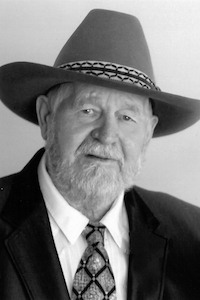Ernest (Ernie) Henry Esau is a true leader in Canadian beef agriculture.
In 1951, Ernmore Shorthorns began with Ernie’s purchase of two purebred Shorthorn heifers. Thinking that the breed was getting too small, Ernie set his sights on improving the breed. By selecting better breeding stock, Ernmore Shorthorns would become bigger framed and better muscled than other Shorthorns of that era.
In 1955 Ernie married Irma and two years later, in 1957, they purchased their own farm—Ernmore Farms. That same year, Ernie officially showed his first animal.
When the federal government decided to wind down the herds at their research farms in Brandon and Indian Head, Ernie took advantage of the opportunity by visiting these herds and personally selecting some very influential sires. These herds had been closed for many years and all selection had previously been based on performance. The sires Ernie selected were bigger, thicker and had more growth than most other Shorthorns in North America. As Ernie would often do, he looked at the size and structure of the animal instinctively knowing that they could be bigger and better. While having no formal training in animal genetics, Ernie was quick to practise line and cross breeding which ultimately resulted in Ernie becoming a trendsetter with his Dual-Purpose Polled Shorthorns.
Ernie spent a short but “expensive time” with the Maine-Anjou breed, which included raising the first polled Maine-Anjou calf ever born in Canada. However, Ernie quickly turned his sights to the more commercially coveted Charolais breed. After amassing a polled Charolais herd from cows and calves across North America, he crossed these with full French Charolais bulls. The results were impressive with Grand Champion prizes and top selling animals at places like the Denver Livestock Market, the Toronto Royal Winter Fair and the Canadian Western Exhibition.
In order to ensure that improvements to the industry were realized around the world, Ernie sold semen from his championship bulls and embryos from his championship cows to places as far away as Australia.
Ernie’s abilities and achievements would often come up in a variety of circles including well respected universities. Agriculture professors often espouse that he was the one responsible for driving significant improvements in the beef cattle industry. Ernie’s highly regarded reputation earned him hundreds of awards including the prestigious Builder of the Breed award from the American Shorthorn Association.
Always one to give back to the beef industry, Ernie served on the boards of the Manitoba Shorthorn Association and the Canadian Charolais Association for many years. He was a livestock judge throughout Canada and the U.S. and a renowned guest lecturer.
Ernie and Irma were most proud of their family consisting of six children, twenty-one grandchildren and twenty-one great-grandchildren.


